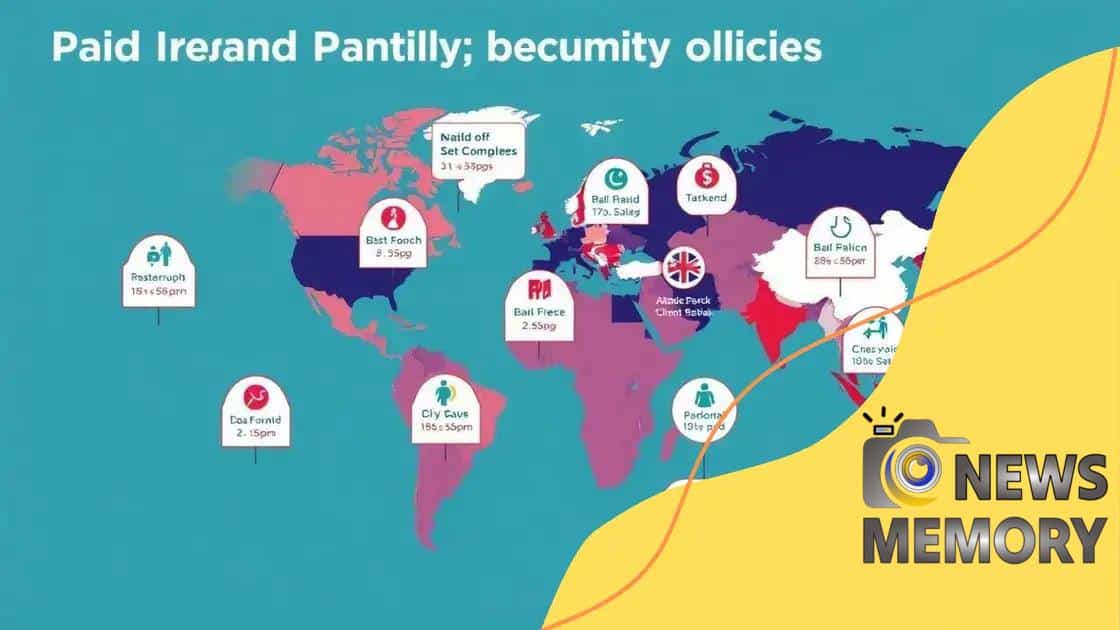The future of paid family leave policies: what to expect

The future of paid family leave policies is marked by increasing advocacy for universal access, advancements in technology to streamline processes, and a growing recognition of the economic and social benefits of supporting families in the workplace.
The future of paid family leave policies is an evolving topic, raising questions about how it affects working families. With growing advocacy for better support, what changes lie ahead?
Current paid family leave policies in the U.S.
Understanding the current paid family leave policies in the U.S. is essential for workers and families. These policies vary greatly across states, affecting how parents manage both work and family responsibilities.
Overview of State Policies
Most states have different policies regarding paid family leave. For instance, California offers one of the most comprehensive paid family leave programs.
- California: Up to 8 weeks of leave.
- New Jersey: Offers 12 weeks of leave.
- New York: Provides benefits for up to 12 weeks.
Understanding these variations can help families navigate their options better.
Eligibility and Benefits
Eligibility for paid family leave typically includes meeting certain work hour requirements. Additionally, the amount of compensation can differ significantly.
For example, many states offer partial wage replacements, often around 60-70% of a worker’s salary. This percentage aims to support families during critical times without a complete loss of income.
As more states consider implementing paid family leave, discussions around its benefits and challenges continue to grow. It’s important for workers to take the time to learn about the policies in their states.
In conclusion, staying informed about current paid family leave policies is crucial for families as they plan for the future. Whether through maximizing benefits or understanding eligibility, knowledge is key to making the most out of these policies.
Impact of paid leave on workforce participation
The impact of paid leave on workforce participation is a critical topic as it influences economic stability and family well-being. When parents have access to paid leave, they are more likely to return to work after having a child.
Benefits of Paid Leave
Paid leave can positively affect women in the workforce. It enables them to maintain career trajectories while balancing family responsibilities.
- Increased job retention rates for parents.
- Improved mental and physical health for both parents and children.
- Higher overall productivity when employees return refreshed.
Moreover, studies have shown that paid leave can lead to a more engaged workforce. As employees feel valued and supported, their loyalty to their employers tends to increase.
Challenges Faced
However, there are challenges to implementing paid leave. Some employers express concerns about potential costs and the impact on small businesses.
In many cases, these fears can be unfounded. Research indicates that the benefits of paid leave can outweigh the costs associated with implementing such policies. For example, businesses may see a decrease in turnover rates and training costs.
As the conversation around paid leave evolves, understanding its impact on workforce participation becomes essential. By investing in their employees’ well-being, companies contribute to a healthier, more productive workplace. This supports not only families but also the broader economy.
Comparative analysis of global paid family leave

A comparative analysis of global paid family leave highlights the differences in policies among various countries and their impacts on families and the workforce. Understanding how different nations approach paid leave can provide valuable insights into best practices.
Countries with Progressive Policies
Some countries are known for their comprehensive paid family leave policies. For instance, Scandinavian countries lead the way in offering extensive support to families.
- Sweden: Offers up to 480 days of paid parental leave per child.
- Norway: Provides 49 weeks at full pay or 59 weeks at 80% pay.
- Denmark: Grants 52 weeks of parental leave, allowing flexibility in taking the time off.
These policies not only support family bonding but also ensure that both parents can share childcare responsibilities without sacrificing their careers.
Comparison with U.S. Policies
In contrast, the U.S. has no national paid family leave policy, which puts it behind many developed nations. While some states have implemented their own plans, these can vary widely.
The lack of a standardized approach can lead to disparities in access, leaving many families without the necessary support during critical early years. This situation can affect children’s well-being and parents’ ability to maintain job security.
Analyzing how countries manage their paid family leave can reveal benefits and drawbacks, encouraging discussions about potential reforms in the U.S. system to better support families.
In summary, a thorough examination of global paid family leave policies showcases the diverse strategies that can enhance work-life balance and improve family support systems across different cultures.
Challenges in implementing comprehensive policies
Implementing comprehensive paid family leave policies comes with several challenges that can hinder progress. A variety of factors impact how these policies are adopted and sustained across different regions.
Cost Concerns
One significant hurdle is the perceived cost of implementing these policies. Many employers worry about how paid leave might affect their bottom line. These concerns can lead to resistance against adopting family leave programs.
- Initial setup costs for small businesses can be daunting.
- Ongoing wage replacement during leave can strain finances.
- Potential impact on hiring and productivity rates may deter support.
Despite these fears, evidence suggests that comprehensive leave can lead to long-term savings by reducing turnover and improving employee morale.
Public Awareness and Advocacy
Lack of awareness also poses a challenge. Many employees may not fully understand their rights or the benefits of paid family leave. Increased education around the advantages of such policies can play a crucial role in fostering a supportive environment.
Further, advocacy is often necessary to push for policy changes. Grassroots movements can help raise awareness and drive legislative action that leads to broader acceptance and implementation of family leave policies.
As organizations and advocates seek to address these challenges in implementing comprehensive policies, the dialogue surrounding paid family leave will continue to evolve. Finding effective strategies to overcome these barriers is key to achieving meaningful reform in family support systems.
Future trends in paid family leave legislation
Understanding the future trends in paid family leave legislation is essential as society increasingly recognizes the importance of supporting families. As more discussions arise, changes are likely to occur in both public policy and workplace practices.
Increased Advocacy
With growing awareness, advocacy groups are pushing for stronger and more inclusive paid leave policies. This movement aims to address the gaps in existing legislation and ensure that more workers can access paid family leave.
- Advocates are calling for universal paid leave to cover all workers.
- Legislation is being proposed in many states to expand current laws.
- Online campaigns are educating the public about the benefits of paid leave.
These efforts can lead to positive changes in how paid leave is perceived and implemented across the country.
Utilization of Technology
Technology is likely to play a significant role in shaping future paid family leave policies. Employers may begin using applications or platforms that streamline the process for applying for and managing leave. Such technology can help:
- Reduce paperwork and administrative burdens.
- Provide resources and support for employees.
- Facilitate communication between employers and employees.
This could contribute to a more efficient utilization of paid leave benefits, making them more accessible to all workers.
As companies adapt to changing societal norms and employee expectations, the trend toward more comprehensive and equitable paid family leave policies will continue. These trends promise to create a work environment where parents can thrive without the stress of balancing family needs and job security.
FAQ – Common Questions about Paid Family Leave Policies
What is paid family leave?
Paid family leave allows employees to take time off work while receiving a portion of their salary, usually to care for a new child or a family member.
How does paid family leave benefit employees?
It helps employees balance work and family responsibilities, promotes job retention, and supports overall well-being.
What are some challenges in implementing paid leave policies?
Challenges include costs for employers, lack of awareness among employees, and the complexity of legislating uniform policies.
What trends are emerging in paid family leave legislation?
Trends include increased advocacy for universal paid leave, the use of technology to streamline processes, and growing public support for comprehensive policies.





